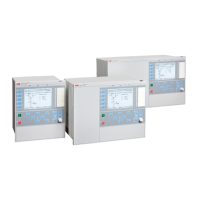It is strongly recommended to use the highest tap of the CT whenever
high impedance protection is used. This helps in utilizing maximum CT
capability, minimize the current, thereby reducing the stability voltage
limit. Another factor is that during internal faults, the voltage developed
across the selected tap is limited by the non-linear resistor but in the
unused taps, owing to auto-transformer action, voltages may be much
higher than design limits might be induced.
Setting example
Basic data:
Current transformer ratio: 2000/5A
CT Class: C800 (At max tap of 2000/5A)
Secondary resistance: 0.5 Ohm (2000/5A tap)
Cable loop resistance:
2
<200 ft AWG10 (one way between the junction point and the
farthest CT) to be limited to approx. 0.2 Ohms at 75deg C gives
loop resistance 2 · 0.2 = 0.4 Ohms.
Max fault current: Equal to switchgear rated fault current 40 kA
Calculation:
( )
40000
0.5 0.4 90
400
VR V> × + =
EQUATION1751-ANSI V1 EN (Equation 36)
Select a setting of
TripPickup
=100 V.
The current transformer saturation voltage must be at least, twice the set operating voltage
TripPickup
.
(0.5 8) 100 *0.7 595VkneeANSI V> + × =
EQUATION1752-ANSI V1 EN (Equation 37)
that is, bigger than 2 ·
TripPickup
Check from the table of selected resistances the required series stabilizing resistor
value to use. As this application requires to be so sensitive select R Series= 500 ohm,
which gives an IED operating current of 200 mA.
Calculate the primary sensitivity at operating voltage, ignoring the current drawn by
the non-linear resistor.
Section 3 1MRK504116-UUS C
IED application
146
Application manual

